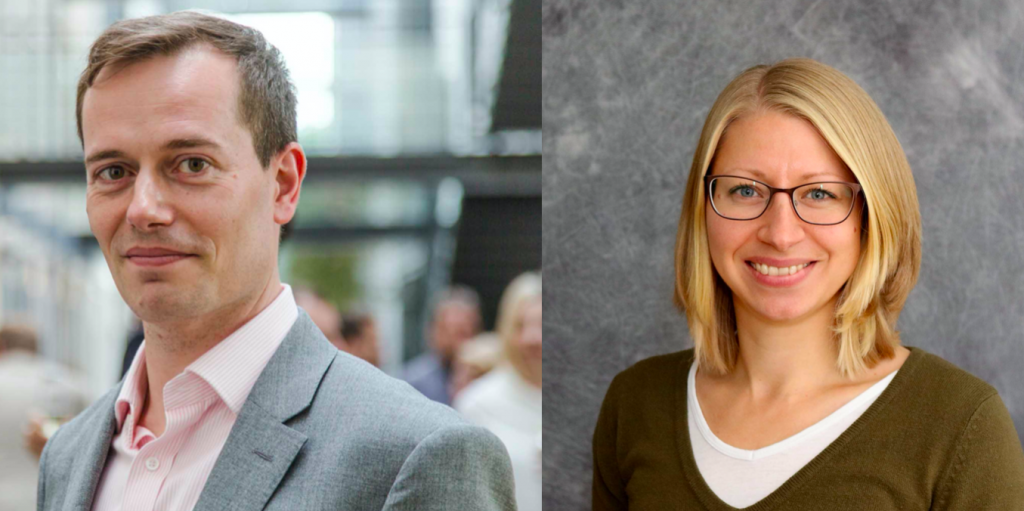Three research news from DAWN: New study captures a “dying” galaxy; two researchers receive grants from the Carlsberg Foundation; and a new study uses gravity as a telescope
Up until now, it was unknown what triggers the process of a dying galaxy. But Assistant Professor Francesco Valentino, from the DNRF’s Cosmic Dawn Center (DAWN) at the Technical University of Denmark (DTU) and the University of Copenhagen (KU), has caught the process with the help of the telescope ALMA and a team of international researchers. The study discovered that the collision of two galaxies triggered the process. The study has been published in the scientific journal Nature Astronomy.

Up until now, it was unknown what triggers the process of a dying galaxy. But Assistant Professor Francesco Valentino, from the DNRF’s Cosmic Dawn Center (DAWN) at DTU and KU, has caught the process with the help of the telescope ALMA and a team of international researchers. The new study caught a galaxy in the process of dying, showing that the collision of two galaxies seems to have started the dying process. The study has been published in the scientific journal Nature Astronomy.
“This is the first time we have observed a typical massive star-forming galaxy in the distant Universe about to ‘die’ because of a massive cold gas ejection,” said Professor Annagrazia Puglisi, lead researcher on the new study, from Durham University.
The collision of galaxies
Researchers have been aware that galaxies die once they stop forming stars, but the exact trigger has been unclear. There are at least two known things that will make a galaxy eject its gas. One way is through winds, which are caused by stars’ light and explosions; the other is through tidal tails. The loss of gas is the reason why galaxies stop forming stars.
The study found out that the collision of two galaxies ended up merging them into one, called ID2299, which meant it lost its ability to form stars and started the process of dying.
“Our study suggests that gas ejections can be produced by mergers and that winds and tidal tails can appear very similar. This might lead us to revise our understanding of how galaxies ‘die,’” said study co-author Emanuele Daddi of CEA-Saclay.
Read more about the study from DAWN in a press release from the ESO here
Read the scientific article in Nature Astronomy here
Two DAWN researchers receive grants from the Carlsberg Foundation
Associate Professor Thomas Greve from the Center of Excellence DAWN at DTU Space and the Niels Bohr Institute at KU has been given a Carlsberg Young Researcher grant, while post-doc Bitten Gullberg, who will soon join DAWN, has received a Reintegration Fellowship.

The Carlsberg Foundation has awarded grants to Associate Professor Thomas Greve from the Center of Excellence DAWN at DTU Space and the Niels Bohr Institute at KU, and post-doc Bitten Gullberg from the Chalmers University of Technology, who will join DAWN later this year. Post-doc Gullberg has received one of the Carlsberg Foundation’s Reintegration Fellowships, while Associate Professor Thomas Greve has received a Young Researchers grant.
“Congratulations to Associate Professor Thomas Greve and post-doc Bitten Gullberg for being awarded the Carlsberg Foundation’s Young Researcher and Reintegration grants. Associate Professor Greve’s grant will fund two Ph.D. students and one post-doc. They will explore the formation and evolution of galaxy clusters over a three-year period. Post-doc Gullberg is currently at the Chalmers University of Technology, but will join DAWN in September,” said astrophysicist and science disseminator Peter Laursen from DAWN.
Star-formation, distant galaxies and black holes
Postdoc Guldberg’s project will provide insight into what drives star-formation in distant galaxies, and the difference between local and distant galaxies. Associate Professor Greve’s project will provide insight into how galaxies clusters form and develop over time, as well as how supermassive black holes in the central of the clusters effect the clusters development.
Read more about post-doc Bitten Gullberg’s grant here
Read more about Associate Professor Thomas Greve’s grant here
New study from DAWN uses gravity as a telescope
A new study from the Center of Excellence DAWN at the Niels Bohr Institute at KU and DTU Space has used gravity as a telescope. The study was led by post-doc Seiji Fujimoto, who has studied a distant galaxy in great detail with the help of gravity itself. The study will soon be published in the scientific journal The Astrophysical Journal.

A new galaxy has been discovered by the Center of Excellence DAWN by using gravity as a telescope. The researchers have studied the distant galaxy in detail, a feat that, until now, wasn’t possible at this distance. Post-doc Seiji Fujimoto is at the forefront of the new study that will soon be published in the scientific journal The Astrophysical Journal.
The galaxy is 28 billion lightyears away, a distance that would normally be too far away for a galaxy to be studied in detail. But the feat was accomplished with the help of a gravitational lens, in which the very gravity of a massive foreground galaxy cluster warps space so much that light from the background galaxy is deflected and amplified. Moreover, the light rays follow different paths through space, so as to render the galaxy visible in multiple places in the sky at once.
The galaxy’s internal structure in detail
The astronomers were able to see the galaxy’s internal structure in greater detail than ever before, revealing that carbon gas lies close to the young stars and the emission from carbon and young stars is similar to that of galaxies in the present-day universe.
”Gravitational lenses are an amazing tool that allows us to study the universe at great distances – thereby we are able to see far back in time. In this case, the galaxy is magnified 1000 times bigger in certain places,” said astrophysicist and science disseminator Peter Laursen from DAWN.
The article from DAWN will be published next month, but is available as a preprint here
